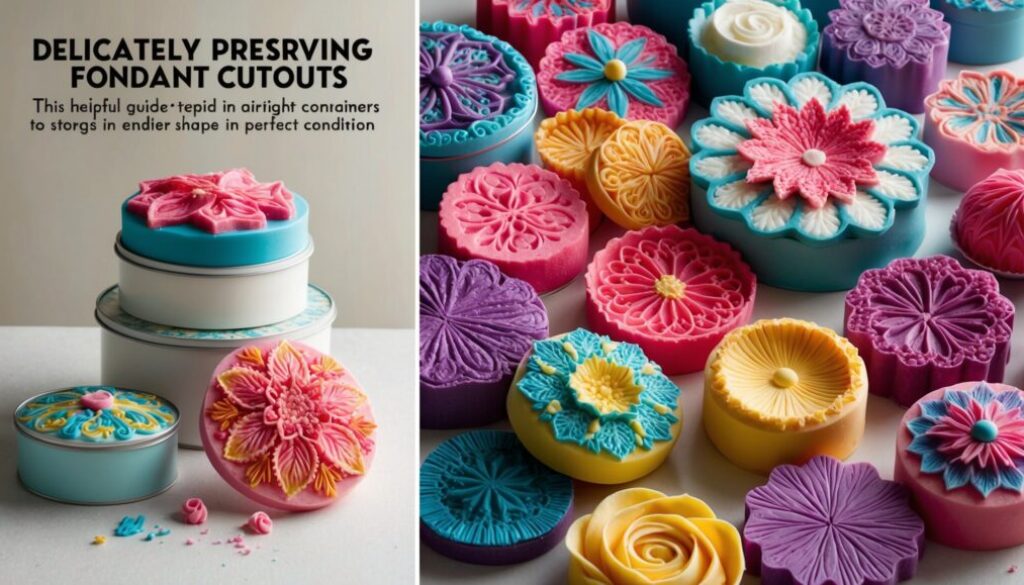How to Store Fondant Cutouts
How to Store Fondant Cutouts: A Comprehensive Guide
Fondant cutouts, those charming little shapes that add a touch of elegance and whimsy to cakes and cookies, require careful handling and storage to maintain their pristine condition. Whether you’ve painstakingly crafted intricate flowers, adorable animals, or simple geometric shapes, preserving their beauty is crucial for a successful baking project. This comprehensive guide explores the best practices for storing fondant cutouts, ensuring they remain perfect until the moment you need them.
Understanding the Challenges of Fondant Storage
Fondant, a pliable sugar paste used extensively in cake decorating, is susceptible to several factors that can compromise its appearance and texture:
- Moisture: Fondant is highly sensitive to humidity. Exposure to moisture can cause it to become sticky, soft, and prone to melting or discoloration.
- Air Exposure: Prolonged exposure to air causes fondant to dry out, becoming brittle and cracking. This is especially true for delicate cutouts.
- Temperature Fluctuations: Extreme temperatures, both hot and cold, can negatively impact fondant’s texture and appearance.

Optimal Storage Conditions for Fondant Cutouts
The key to successfully storing fondant cutouts lies in creating an environment that minimizes moisture, air exposure, and temperature fluctuations. Here’s a breakdown of the best practices:
1. Pre-Storage Preparation:
- Drying: Before storing, allow your fondant cutouts to completely dry. This process minimizes stickiness and prevents them from sticking together. Drying time varies depending on the thickness and complexity of the cutout, but generally takes several hours to overnight in a cool, dry place.
- Proper Handling: Handle dried fondant cutouts gently to avoid damage. Use clean, dry tools and surfaces to prevent contamination.
2. Storage Methods:
- Airtight Containers: The most effective method is to store dried fondant cutouts in airtight containers. These containers prevent moisture from entering and maintain a consistent environment. Choose containers made of food-safe materials such as plastic or glass. Avoid using containers that are prone to absorbing odors.
- Plastic Wrap: If airtight containers aren’t available, wrap your cutouts tightly in multiple layers of plastic wrap. This minimizes air exposure and helps retain moisture. Ensure the plastic wrap is food-grade and doesn’t contain any chemicals that could leach into the fondant.
- Silicone Sheets: Silicone sheets provide a non-stick surface that prevents the cutouts from sticking together during storage. Place the dried cutouts on a silicone sheet before wrapping them in plastic wrap or storing them in an airtight container.
- Placement: Store the containers in a cool, dark, and dry place, away from direct sunlight, heat sources, and strong odors. Avoid storing them in the refrigerator or freezer, as temperature fluctuations can damage the fondant.
3. Storage Duration:
- Short-Term Storage (Up to a Week): Properly stored fondant cutouts can be kept at room temperature for up to a week without significant degradation.
- Long-Term Storage (Several Weeks to Months): For longer storage, consider using a food-safe, airtight container with a desiccant packet to absorb excess moisture. Keep the container in a cool, dark, and dry place. Even with optimal storage, some minor changes in texture or color may occur over time.

Troubleshooting Common Fondant Cutout Storage Problems
- Sticky Fondant: If your fondant cutouts become sticky, it indicates excessive moisture. Allow them to dry completely before re-storing in a more airtight environment.
- Brittle Fondant: Brittle fondant is a sign of excessive dryness. Wrap the cutouts in a damp paper towel for a short period to rehydrate them slightly, then store them in an airtight container.
- Discoloration: Fondant can discolor if exposed to light or strong odors. Store cutouts in a dark, odor-free place.

Specific Considerations for Different Fondant Types
While the general principles of storage apply to all types of fondant, some variations exist:
- Homemade Fondant: Homemade fondant tends to be more susceptible to moisture and drying than commercially produced fondant. Pay extra attention to airtight sealing and moisture control.
- Gumpaste: Gumpaste, a firmer type of fondant, is less prone to moisture damage but still benefits from proper storage to prevent cracking.
- Pre-made Fondant Cutouts: Pre-made fondant cutouts often come with specific storage instructions. Always follow the manufacturer’s recommendations.

Advanced Storage Techniques: Freezing Fondant Cutouts
While not ideal for maintaining the best quality, freezing fondant cutouts is possible for long-term storage. Follow these steps:
- Flash Freeze: Place the cutouts individually on a baking sheet lined with parchment paper and freeze them until solid.
- Transfer to Freezer-Safe Bags: Once frozen, transfer the cutouts to freezer-safe bags, removing as much air as possible.
- Label and Date: Label the bags with the date to track storage duration.
- Thawing: Thaw the cutouts overnight in the refrigerator before using.
Note: Freezing can slightly affect the texture of the fondant, making it slightly less pliable. It’s best to avoid freezing if possible.

Conclusion
Proper storage is essential for preserving the beauty and quality of your fondant cutouts. By following the guidelines outlined above, you can ensure your creations maintain their charm and elegance, ready to enhance your baking masterpieces. Remember that prevention is key – meticulous attention to drying and storage practices will yield the best results.







